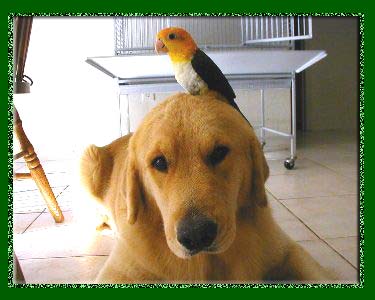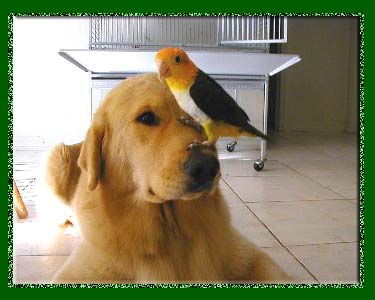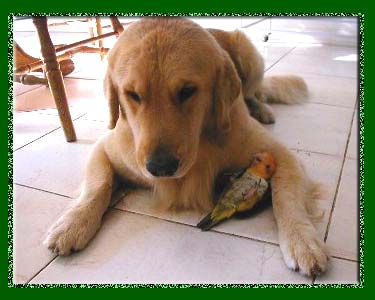Relatively
new to the avian pet trade, caiques (pronounced "ki-eeks")
are quickly making their mark in the world of aviculture and
are gaining much-deserved popularity with their bright, festive
coloring and playful, active personalities. These cocky yet
clownish little birds are as friendly and outgoing as they
are curious, their talking ability has proven to be more than
adequate, and their entertaining antics are a welcome delight
to any observer. From all appearances, these energetic little
beauties possess almost all of the most sought-after traits
that are considered desirable in a companion parrot.
 Currently
the most commonly available species is the black-headed caique,
originating North of the Amazon and westward to parts of Venezuela,
Ecuador and Peru. These birds sport a deep, rich forest green
color on their backs, wings and tail. The top and upper back
of the head is a shiny jet black; the nape and neck is a vivid
yellow/orange, and the beak is black. There is a hint of dark
green around the eyes, and the entire front of the belly and
breast area is a soft cloudy white. "Socks" and
the underside of the tail is burnt orange. This parrot measures
approximately nine inches in length, and their sex is undeterminable
by visualization.
Currently
the most commonly available species is the black-headed caique,
originating North of the Amazon and westward to parts of Venezuela,
Ecuador and Peru. These birds sport a deep, rich forest green
color on their backs, wings and tail. The top and upper back
of the head is a shiny jet black; the nape and neck is a vivid
yellow/orange, and the beak is black. There is a hint of dark
green around the eyes, and the entire front of the belly and
breast area is a soft cloudy white. "Socks" and
the underside of the tail is burnt orange. This parrot measures
approximately nine inches in length, and their sex is undeterminable
by visualization.
The
less common but increasingly available species is the white-bellied
caique, whose habitat is South of the Amazon, from northern
Brazil and spreading to parts of Bolivia, Ecuador and Peru.
The appearance of the white-bellied species is almost identical
to the black-headed, with two striking exceptions: the beak
of the white-bellied caique is horn colored, and the entire
head is a bright yellow/orange, giving this species the
appearance of wearing a hood. The abrupt color changes from
one part of the body to another are so pronounced on both
of these birds that they look as if they have been painted
on! The white-bellied species is slightly smaller in size
measuring approximately eight inches in length, and again,
this species is not sexually dimorphic.
 Caiques
are surprisingly small but heavy to those who have not previously
encountered them; their body build is compact and stocky
with a "barrel"-like chest and short, square-shaped
tail. The average weight of an adult is approximately 150
to 175 grams, and their average lifespan is 30 years. They
have a relatively narrow wing span and this, coupled with
their weight, prevents them from flying long distances.
In their native habitat, small flocks have a tendency to
group together in treetops. Their chattering and verbal
interactions among themselves can become quite loud, and
they take flight quickly when approached, returning only
when they sense the "intruder" has departed.
Caiques
are surprisingly small but heavy to those who have not previously
encountered them; their body build is compact and stocky
with a "barrel"-like chest and short, square-shaped
tail. The average weight of an adult is approximately 150
to 175 grams, and their average lifespan is 30 years. They
have a relatively narrow wing span and this, coupled with
their weight, prevents them from flying long distances.
In their native habitat, small flocks have a tendency to
group together in treetops. Their chattering and verbal
interactions among themselves can become quite loud, and
they take flight quickly when approached, returning only
when they sense the "intruder" has departed.
As
with most avian species, the personality traits of the caique
differ with each individual bird. Some exhibit the "Show
me you love me" desire to be petted and cuddled more
than others, but the overall pet potential of these charming
little clowns is very hard -- if not impossible -- to surpass.
They are rambunctious, energetic little pistols who sometimes
seem to never wind down! They are very social, happy-go-lucky
birds by nature, and love attention from their humans. Their
work is to play, and they do play hard! They are quite coordinated,
and some of their natural daily antics will consist of climbing
up, down, over, around and under; swinging; tumbling; wrestling;
rolling; hanging; jumping; and perhaps the most amusing
of all, bunny-hopping. This entertaining-to-watch activity
has thus far been noted to be specific to caiques and the
etiology is unknown, which only serves to to heighten their
uniqueness and desirability as companion parrots.
Well-known
behavior specialist Sally Blanchard shares her life and
love with an adorable black-headed caique named Spike. Spike
often accompanies Sally to lectures, where she demonstrates
his exuberance for this hopping activity by placing her
hand on his back, grasping him around his middle and pretending
to "bounce" him up and down. Much to the delight
of spectators, Spike will continue "bouncing"
and bunny-hopping long after Sally has released him!
Caiques
are energetic, busy little birds, and caution must be exercised
during playtime to prevent biting that can stem from "emotional
overload". To keep them entertained, provide a multitude
of toys to hold their attention. They especially love those
that either make noise, or assist them in their "travels";
such as bells, balls, ropes or hoops. They prefer things
that provide movement, and swings are high on the list of
favorites. Because their activity level is so high, they
need toys such as acrylics that can withstand hard play;
and like all companion parrots they need "destructible"
wooden toys to satisfy their chewing instincts and keep
their beaks in shape. Natural, bird-safe branches are a
favorite. Toys should be rotated on a regular basis to prevent
boredom.
 The
talking ability of this species is not notably impressive
as with the African Grey; but they easily speak well enough
to be understood if you listen closely. They have tiny,
high-pitched voices that are similar in sound to that of
a budgie. They spend a good deal of time chattering to each
other and can become quite noisy when socializing. They
quickly learn to whistle musical tunes, and seem to prefer
mimicking those whistled by their owners as opposed to what
they hear on a radio or television. These parrots are intelligent,
and teaching them to perform tricks is usually quite simple.
Potty-training is also quite easy for them to master. It
has been noted that hand-raised, tame caiques will remain
loving to their humans even after being paired with a potential
mate; they do not often exhibit the tendency to become "one-owner"
birds.
The
talking ability of this species is not notably impressive
as with the African Grey; but they easily speak well enough
to be understood if you listen closely. They have tiny,
high-pitched voices that are similar in sound to that of
a budgie. They spend a good deal of time chattering to each
other and can become quite noisy when socializing. They
quickly learn to whistle musical tunes, and seem to prefer
mimicking those whistled by their owners as opposed to what
they hear on a radio or television. These parrots are intelligent,
and teaching them to perform tricks is usually quite simple.
Potty-training is also quite easy for them to master. It
has been noted that hand-raised, tame caiques will remain
loving to their humans even after being paired with a potential
mate; they do not often exhibit the tendency to become "one-owner"
birds.
They
have no special dietary requirements; pellets supplemented
with fruits, vegetables and other foods common to parrots
will satisfy their needs and requirements. They do have
a fondness for chewing natural green branches, so providing
a supply of these is recommended.
Possessing
so many positive traits that are sought by bird owners,
I believe that caiques are well on their way to becoming
one of the most opular companion parrots in existence. Their
reasonable purchase price ($750 -- $1000) is well within
the range of other popular species, and the recent increase
in successful breeding attempts by many avicuturists definitely
ensures that we will be hearing and seeing more of these
cuddly little clowns!
